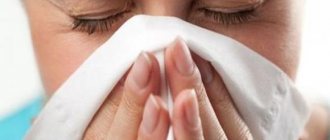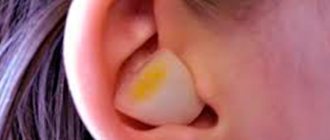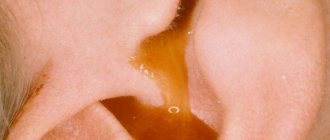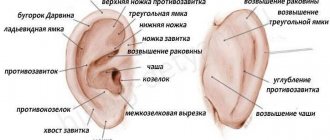Otitis is an inflammatory process in any part of the hearing organ as a result of infection. Basically, the condition is accompanied by a course of purulent exudate, and sometimes it may contain blood impurities. Discharge from the ear due to otitis media in a child frightens parents. Today we will look at what fluids can be observed with this disease, and what is a symptom of another pathology.
Why does otitis media occur in children?
Everyone is familiar and understands the appearance of snot when you have a runny nose or phlegm when you cough. These diseases are very common and therefore do not cause panic. Ear inflammation is a rare problem in comparison, and therefore the discharge is scary. There are several reasons for the occurrence of pathology in a child:
- As complications of rhinitis, sinusitis or inflammation of the tonsils;
- Foreign object - small toys, pebbles, insects;
- Water ingress due to minor ear injuries;
- Any injuries to internal tissues in the presence of bacteria can become infected;
- A decrease in the body's defenses gives impetus to the proliferation of existing pathogenic microbes;
- The use of drugs, for example, antibiotics from the aminoglycoside group, which accumulate in the tissues of the inner ear, causing harmful toxic effects. These include neomycin, streptomycin, kanamycin;
- Viral infections of the ENT organs, including influenza.
Attention! Hypothermia is often a provoking factor for ear inflammation and the development of otitis media, in which case people say “bloated”. Moreover, not only a cool atmosphere, but also drinking ice water can provoke a decrease in immunity for this reason.
Classification
Depending on the location of the process, otitis media is divided into 3 types:
- The internal one is located deep in the organ of hearing. It is otherwise called labyrinthitis. May be a complication of untreated otitis media. The pain is insignificant or absent altogether. There is a decrease in hearing and dizziness.
- The middle one occurs in the same area of the ear just behind the eardrum. In this case, purulent exudate flows out with difficulty, which complicates the course of the disease.
- External occurs when tissue in the ear canal is damaged. It is often a consequence of injury or suppuration of a boil. It is the easiest to treat and is characterized by more obvious discharge, since nothing interferes with their outflow.
Based on the type of infectious agent, otitis media are also divided into 3 groups:
- Bacterial most often occurs against the background of reduced immunity. The culprits are mainly staphylococci and streptococci.
- Viral for complications of acute respiratory viral infection or influenza, as well as the introduction of a herpetic infection into the ear cavity.
- Fungal or otomycosis. Provoking factors are decreased protection, poor hygiene, the postoperative period, and taking antibiotics for a long time.
Attention! Rarely, but still, allergic otitis occurs, when the inflammatory process is associated with exposure to an allergen on the body with corresponding rhinitis or bronchial asthma.
Symptoms of otitis media in a child
First, let's talk about the general clinical picture of ear inflammation, which causes the following symptoms:
- Cutting and shooting in the organ of hearing. The baby cannot tell about the pain, but by observing him you can notice strong crying and attempts to tilt his head, press his ear, and a reaction to touching this area;
- An unpleasant, repulsive odor from the ear confirms the presence of a purulent process, although there may be no discharge with otitis media and internal otitis;
- Sometimes the temperature rises to extremely high values or stays around 37-38 degrees;
- General malaise, as with any infectious process. Moreover, bacterial otitis literally chains the child to the bed, the skin is pale and cold on the arms and legs even at elevated temperatures;
- Itching may occur, especially with fungal infections;
- Discharges do not always occur. Next, we will consider in detail what they are.
Fluid from the ear with otitis media
By the nature of the mass flowing from the ear, the type of pathogen and disease can be determined. But only a doctor can make a reliable diagnosis after diagnostics and tests. Therefore, the information is provided for informational purposes only.
Transparent and liquid
Mainly accompanying allergic diseases. They have no distinct odor and flow out like water. Accumulations of sulfur in the form of brown lumps may be released with the discharge.
Sometimes this occurs with viral otitis media. In this case, it can be distinguished from an allergic one by general malaise and increased temperature.
Also, clear discharge from the ear opening occurs when the base of the skull is fractured and the eardrum is damaged.
Attention! With a traumatic brain injury, it leaks not only from the ears, but also from the nose, which indicates a rupture of the membrane of the brain. Therefore, urgent medical attention is required.
Yellow
Such discharge has an unpleasant odor because it is purulent. This is a sign of bacterial or fungal otitis media. Accompanied by severe pain in the parotid region of the head, fever, and general malaise. Complications can include meningitis, sepsis, and brain abscess.
Sometimes yellow discharge is just melted sulfur. This happens under the influence of high temperatures and high humidity, for example, in a bathhouse. There is no putrid odor or other symptoms of infectious otitis media.
White
Such discharge sometimes accompanies a special form of seborrheic dermatitis. They accumulate outside the opening of the ear canal. An accompanying symptom may be mild itching.
Curdled masses of gray, cream and white shades, sometimes with black dots, are a clear symptom of otomycosis. Fungal otitis is accompanied by severe itching, redness and swelling of the tissues of the ear canal.
Greens
A variant of purulent discharge in bacterial or viral otitis. They have an unpleasant odor and are accompanied by symptoms of general malaise and increased body temperature.
Brown
There are 2 possible options:
- Thick masses are dissolved sulfur plugs;
- More liquid discharge of this shade is old blood as a result of internal damage.
Blood from a child's ear
A small amount may indicate some kind of injury. Sometimes this happens as a result of scratching during otitis media. If bloody discharge appeared first, and then other signs, then the root cause of the pathology was trauma to the tissues of the hearing organ. When blood occurs against the background of acute inflammation, the eardrum may have ruptured due to the accumulation of pus in the middle ear. In such a situation, blood will be present in the exudate as an inclusion.
Carefully! When the eardrum ruptures, significant relief occurs, but dangerous inflammation continues to develop. If measures are not taken, the child may permanently lose hearing and even die from complications in the form of meningitis and sepsis.
Other symptoms without abnormal fluid
Description of otitis in adults and children
Otitis or otorrhea is the discharge of a certain fluid from the ear. This process occurs due to the origin of pathological processes in the body, which often occur in the hearing organs and their tissues.
In total, there can be quite a lot of reasons for such a negative process, but the color, consistency and smell of the liquid can clearly determine the main one.
According to statistics, the most common cause is an infection that affects the ear cavity. Head injuries are also among the most common causes.
There are cases when a person perceives ordinary wax as a pathological discharge from the ear, because in certain cases it can be of a liquid consistency.
Sulfur , which is produced by certain glands, can appear in abundant form when playing sports or other physical activities. This process is normal for humans.
Depending on the color of the discharge, there are various reasons , let's consider them briefly:
- If the discharge occurs in a purulent form, then this indicates the external appearance of otitis media or fungal inflammation of the ear. It may also be caused by a boil that has opened and its fluid has leaked out.
Otitis media can damage the eardrum. And other exacerbations of otitis media; - If the discharge is bloody, then the cause of this process is various injuries to the head and ears, various tumors in the outer and middle ear;
- If the fluid from the ear is clear in color, then the reasons may be more complex. One of the reasons for this phenomenon is rupture of the eardrum . This problem can arise in the case of otitis media of the exudative type.
In this case, fluid accumulates in the middle ear, but there are no inflammatory processes in the body. Another reason for this type of fluid is an allergic reaction . And a fairly serious cause is head trauma , in which fluid such as cerebrospinal fluid leaks from the ear. As a rule, this is accompanied by a skull fracture.
Wax leaks from a child's ear: causes, provoking factors, treatment
Earwax plays a protective role, but sometimes it causes problems.
Sometimes people think that it is dirt, so they try to get rid of it. But thanks to it, the natural microflora is preserved in the ears, protected from pathogenic microorganisms. The volume of sulfur should be carefully monitored. Excessive production can lead to the formation of sulfur plugs and the closure of the hearing organ. Therefore, it is important to promptly recognize problems occurring in the body.
Functions of ear secretion
It is a yellow-brown secretion that looks like a lubricant. It is produced by sulfur glands. It is needed to clean and lubricate the ear canals. There are 2,000 cerumen glands in the outer ear. Thanks to them, 12-20 mg are released. earwax per month. It consists of proteins, fats, and mineral salts. Some proteins are represented by immunoglobulins, which determine the protective function.
The acidity level corresponds to 4-5. This allows protection against the development of bacterial or fungal flora. Physiological functions include moisturizing and protecting the skin. Sulfur, along with particles of dust and dead cells, is naturally removed to the outside.
Chewing movements help her with this. But many people have natural prerequisites for hypersecretion, as well as a narrow shape of the ear canal. This leads to accumulation of the composition and the formation of traffic jams.
For information on the protective functions of earwax, watch our video:
Causes of excessive discharge of wax from a child’s ear
Only an otolaryngologist can find out the cause of heavy discharge from the ear after examination and diagnosis. There can be many reasons for such a problem. Depending on them, the specialist gives recommendations for care and treatment. The prerequisite may be:
- Dermatitis. It can be allergic or infectious. Since inflamed areas can be anywhere in the body, their appearance in the ears leads to the appearance of a large amount of wax and a change in its consistency.
- Excess cholesterol. A regular diet will help cope with the problem. In children, this cause is one of the rarest.
- Headphones and hearing aids. The presence of foreign bodies leads to the production of a large amount of secretion for protection.
- Prolonged stay in dusty rooms. Microparticles enter the ear canal. The body strives to get rid of them faster.
- Inflammation of the middle ear. One of the most common causes in children under 4 years of age. During inflammation, the skin becomes irritated. There is an increase in the flow of lymph and blood. Therefore, the ceremonial glands begin to work faster.
- Great cleanliness. If parents constantly remove sulfur from a child, its increased production begins in the body.
The process is also activated during a cold. In this case, sulfur performs a protective function, preventing penetration into the hearing organs. In older children, increased secretion production begins due to hormonal changes.
The photo shows copious discharge of wax from the ear.
How to fix
Since the reasons that led to profuse discharge from the ear are different, the methods also differ. The most common cause is the formation of sulfur plugs. While it is easy for adults to remove it, it is better to take children to the doctor, since it is much easier for them to be harmed.
At home
If no pathological processes are detected in the ear, ensuring ear hygiene will be sufficient. For babies, parents should remove excess wax. At school age, this responsibility falls on the shoulders of the teenager. It is important to explain all the rules for safe cleaning of the ear canal.
At home you should:
- Avoid using vacuum headphones. If the cause is a hearing aid, then you need to carefully monitor its hygiene.
- If the reason was visiting dusty premises, then nothing should be done. Excess secretion indicates that the child’s body is functioning normally.
- When a sulfur plug forms, rinsing is carried out. First, it can be dissolved by dropping 3% hydrogen peroxide into the ear.
Note! Do not clean the ear canal with olive or other oil. It is only suitable for external hygiene. For children, to treat the outer ear, you can moisten a cotton wool in castor oil.
How to properly clean ear wax
Medication
You can buy Remo-Vax at the pharmacy to wash your ears. It softens and removes excess wax from the ear cavity. Can be used to prevent increased sulfur production or when using hearing aids or headphones.
The medical institution will offer to rinse the ear using a special Janet syringe. The procedure should only be performed by a doctor, since improper water pressure can damage the eardrum. You should not warm up the ear if a large amount of wax is released. This can lead to the proliferation of pathogenic microflora.
If the excessive formation of wax in a child is associated with inflammation of the middle ear, then treatment is carried out with local or systemic drugs. In this case, after the course and recovery, the amount of secretion is normalized.
How to clean your child's ears, watch our video:
Prognosis and prevention
The prognosis is favorable if hygiene rules are observed. If you notice that there is a large amount of wax in your ear, do not try to remove it yourself. This method will only lead to more pushing. Sometimes it also causes inflammation or otitis media.
If the baby also begins to cover his ears with his hands when crying, complaining of pain, shooting in the ears, this is a reason to show him to the doctor. Additionally recommended:
- Avoid freezing your head and ears.
- Limit your stay in dusty areas.
- Carry out hygiene procedures carefully.
- Receive medical advice in a timely manner.
The increased formation of earwax cannot be ignored. This may signal serious problems and disorders in the body.
For prevention, clean only the child’s external passage. Once every two weeks will be enough. In this case, you only need to remove the sulfur that has leaked out. If the baby begins to complain during such manipulation, this is a reason to visit a doctor. Be sure to dry your child’s ears after water procedures with the tip of a towel. This will avoid a lot of water in the channel.
Source: https://gidmed.com/otorinolarintologija/simptomu/u-rebenka-techet-sera.html
Causes of ear discharge in adults
In the case of adults, fluid from the ear may not always indicate that some kind of ENT disease is present in the body.
Quite often there are cases where, along with otitis, an adult feels itching in the ear and severe pain .
In the human ear, fluid accumulation in most cases occurs due to certain inflammatory processes.
In addition to the above reasons, there may also be the following:
- traumatic brain injuries;
- various types of polyps;
- opened types of boils;
- seborrheic type dermatitis;
- bullous otitis.
The color of the liquid and its type depend directly on the type of disease.
If the area of the middle or inner ear is affected, then the liquid secretion indicates that the eardrum has been damaged. If the membrane is destroyed, this leads to various possible complications.
Based on this, it is not difficult to guess that if the slightest symptoms appear, you need to go for an examination to a specialized doctor.
Diagnostics
Otorrhea is a dangerous manifestation that requires immediate examination and treatment. Diseases of the hearing organs rarely disappear on their own and often cause complications. It is simply impossible to independently establish a diagnosis or prescribe a course of effective treatment.
To diagnose the causes of ear discharge, it is important to have a detailed medical history. Often the development of otorrhea is facilitated by: injuries, sports, past illnesses, surgical operations, infections, as well as foreign objects accidentally falling into the ears.
To make the diagnosis more reliable, the doctor may prescribe a computed tomography scan of the temporal region of the head, sinuses, or teeth, or audiometry. You will definitely need to have your blood tested.
Causes of ear discharge in children
brown fluid is observed from the ears , this indicates a certain pathological process. But often it's just ordinary earwax.
In children, the amount of earwax increases, especially in the hot season.
The child’s body, or rather the glands that secrete sulfur, begin to secrete it more actively in the event of physical activity or playing sports. Experts assure that this process does not have a negative impact on the child’s body.
But a liquid of a different color should cause concern among parents. This liquid includes:
- Watery consistency - appears only in the case of so-called allergic otitis media;
- Bloody type discharge .
This color indicates a skull injury and a fracture of the bones of the base of the skull. Also, injuries to the hearing organs can indicate blood type discharge. Injuries to the hearing organs include rupture or other destruction of the eardrum; - Formations of the blood type with pus indicate that various types of polyps have formed in the ear canal, which indicates a malignant neoplasm. This process tends to develop in acute meningitis.
Quite often, various discharges from the ears appear due to respiratory tract diseases and dermatitis.
If a child has discharge of a purulent type, but the color is yellow or green, then this indicates inflammation of the hearing organs due to the penetration of a certain type of bacteria.
This color can also cause dermatitis, which is also caused by a certain bacterium.
In all cases of fluid appearance, it is imperative to show the child to a specialized doctor. There are also cases when fluid from the ear is accompanied by a number of other symptoms:
- swelling of certain tissues;
- elevated temperature;
- pain in the ear and ear canal;
- quite frequent headaches.
It is very important to identify the cause as early as possible and begin treating it.
Discharge from the ear with an unpleasant odor: causes and treatment
Patients often turn to a specialist with complaints of liquid discharge from the hearing organs. This phenomenon is not considered an independent disease, but indicates the progression of various pathologies of the ear, nose and throat in the human body.
The process of fluid secretion from the organ of hearing is called “otorrhea” in medicine, which requires mandatory treatment. Discharge from the ear with an unpleasant odor can signal an inflammatory process in the spinal cord or the development of a disease such as otitis media. To identify pathology, the specialist pays attention to the color of the discharge, its type, abundance and duration. Taking into account such indicators, the patient is diagnosed and effective treatment is selected.
Causes of ear discharge
Discharge from the ears with an unpleasant odor indicates the development of a pathology; you should consult a doctor for examination.
The appearance of dark-colored discharge from the hearing organs is usually perceived by people as a pathological phenomenon. In fact, this is earwax, which is considered the absolute norm for a healthy person.
Sulfur production is carried out by special glands, which are activated and begin to function intensively during high physical activity. This is especially pronounced when playing sports and physical exercise. In addition, a person begins to experience increased sweating, which is accompanied by increased formation of sulfur. In fact, such a physiological process is considered absolutely normal and does not cause any discomfort to the patient.
Experts identify some reasons that can cause discharge from the ears of a specific nature. With an injury such as a skull fracture, cerebrospinal fluid begins to leak from the hearing organs. In addition, the development of otitis media of allergic origin can provoke the appearance of watery discharge. The appearance of discharge mixed with blood can be observed with various injuries to the hearing organs and with a ruptured eardrum. In some cases, bloody fluid from the ears appears due to a malignant neoplasm in the outer or middle ear.
Patients often complain of the appearance of yellowish-green discharge mixed with pus, which may signal an inflammatory process of a bacteriological nature.
With the development of a disease such as epitympanitis, a yellow-green discharge with an unpleasant odor appears. In addition, such discharge appears in the following pathologies:
- external and otitis media, accompanied by perforation of the eardrum
- bacterial dermatitis
- furunculosis of the external auditory canal
- mastoiditis
Polypous formations in the ear cavity can provoke the appearance of bloody discharge mixed with pus. If white or gray discharge with a cheesy consistency occurs, a disease such as otomycosis can be suspected.
The development of serous-hemorrhagic otorrhea occurs with acute infectious meningitis. This pathology is accompanied by the formation of blisters with hemorrhagic contents on the membranes, which gradually burst.
Often the appearance of discharge from the hearing organs is associated with various pathologies of the respiratory and eye organs. This is due to the fact that all these organs are interconnected and the infection gradually spreads to the ears. Bullous otitis of viral origin causes the appearance of pinkish fluid, and seborrheic dermatitis is characterized by white discharge with large flakes.
Dangerous symptoms of the disease
Depending on the reasons that caused the appearance of discharge from the ears, various types of pathologies are diagnosed and each of them causes the development of certain symptoms. Most often, patients complain of the appearance of:
- painful sensations in the hearing organs
- severe itching
- hearing problems
- noise and ringing in the ears
In addition, red coloring of the ear canal, nasal and ear congestion, severe runny nose and signs of intoxication may be observed.
If the cause of discharge from the hearing organs is damage to the spinal cord, patients complain of a rise in body temperature, the appearance of white fluid from the ears and pain in the temples. This condition is considered quite dangerous and requires mandatory consultation with a specialist.
With a pathology such as mastoiditis, the patient complains of discharge mixed with pus, headache and severe fever. In the absence of timely effective therapy, there is a danger of developing various complications in the brain.
Acute otitis media is considered one of the common diseases in children and adults, which is accompanied by the appearance of unpleasant discharge from the ears.
Characteristic symptoms for this disease include pain in the hearing organs, severe fever and copious discharge with pus. In childhood, this disease often develops as a complication after acute respiratory viral infection. There is not only the development of pain and intoxication syndrome in the child, but also a deterioration in his general condition.
With acute otitis media, the child constantly cries, is capricious and complains of pain in the ear. After purulent discharge begins to flow from the organ of hearing, pain noticeably decreases and the patient’s condition is restored.
More information about acute otitis media can be found in the video:
Read also: Compress on the ear: types of compresses and how to place it correctly
With the development of a disease such as bacterial dermatitis, purulent otorrhea, hyperemia and crusts appear in the area of the ear canal. An allergic attack can be suspected by symptoms such as clear discharge in combination with lacrimation and rhinitis.
Ear cholesteatoma is accompanied by the appearance of discharge from the ears with an unpleasant odor. This pathology is characterized by a cyst-like proliferation of epithelial tissue that covers the surface of the middle ear. This pathological condition is accompanied by the appearance of aching painful sensations and a constant feeling of pressure in the ear. In addition, the patient complains of constant dizziness, which is accompanied by disruption of the vestibular apparatus. Ear cholesteatoma requires mandatory treatment, which will help avoid the development of many complications. If the cyst is not removed in time, such a disease can result in hearing loss and even death of the patient.
Features of the treatment of discharge from the ear
Treatment directly depends on the cause of ear discharge with an unpleasant odor.
If discharge from the hearing organs appears, the patient is prescribed regular toileting in an ENT office, which involves cleansing the external auditory canal using a special ear pump and micro-instruments. This will help the drugs penetrate the mucous membrane and skin.
Methods of treating the disease:
- When diagnosing external and otitis media with perforation of the eardrum and chronic otitis media, treatment is carried out using antibacterial drops. Such medications should only be prescribed by a doctor, since some of them are contraindicated if the integrity of the eardrum is damaged.
- If the cause of discharge from the ear is a boil, a specialist will open it under local anesthesia. After this, careful cleaning of the ear canal and taking antibacterial drugs are prescribed. When bloody discharge from the hearing organs appears, it is important to find out the origins of the bleeding and, taking this into account, select the necessary treatment.
- If the eardrum is ruptured after injury, a strip of rubber glove can be installed to speed up its recovery. If the perforation does not heal on its own, special materials are used to close it.
- In severe cases of cholesteatoma, mastoiditis and otitis, surgical intervention is resorted to. During the operation, the infected bone tissue is removed and the integrity of the eardrum is restored.
- When discharge from the hearing organs appears, antibacterial drugs are often prescribed, among which the most effective are: Levofloxacin, Suprax, Cefuroxime Axetil. The course of treatment with antibacterial drugs should last at least 10 days. In addition, antibacterial drops such as Normax or Otofa should be instilled into the ears several times during the day.
Read also: Acute purulent otitis: stages, symptoms and treatment of the disease
In the event that the treatment does not bring a positive result or the patient’s condition only worsens, then it is necessary to seek help from a specialist as soon as possible. If the localization of the inflammatory process becomes the brain area, this can pose a danger to the patient’s life.
Traditional medicine against disease
Aloe has an anti-inflammatory effect, so traditional medicine uses it to treat purulent otitis media.
Traditional medicine provides good results in the treatment of discharge from the hearing organs. It should be remembered that they should be used only after consultation with a specialist, because self-treatment can further aggravate the patient’s condition.
At home, you can use the following folk recipes:
- Plantain juice has a bactericidal effect, so if there is an inflammatory process in the hearing organs, you can instill it several times a day.
- You can prepare a decoction from ingredients such as mint and honey, which is used for instillation into the hearing organs.
- Aloe juice, squeezed from a plant leaf, is considered an effective medicine. It should be remembered that it cannot be instilled in its pure form, but must be diluted with water in a 1:1 ratio. This product can cause increased skin dryness and irritation, so it is not recommended to use it more than once a day.
Discharge from the ears can signal the progression of dangerous pathologies in the human body, which can lead to death. If such an unpleasant symptom appears, you must seek help from a doctor and follow the treatment prescribed by him.
Share with your friends! Be healthy!
tvojlor.com
Leaking from a child’s ear: clinical picture
If fluid flows out of the ears profusely, this is a sure sign of ear pathology. There are often accompanying symptoms: fever, hearing problems, chills, shooting ear pain, dizziness, itching.
The appearance of liquid should immediately alert parents. It is important to remember that self-medication can be harmful, and the use of medications before an accurate diagnosis by an ENT specialist is not recommended. After examining the child, the doctor will make a diagnosis and prescribe adequate therapy.
The causes of ear discharge are as follows:
- infectious, fungal and viral diseases, including otitis media;
- damage to the eardrum;
- water or dirt that has entered the ear canal;
- traumatic cleaning;
- using unsuitable hearing aids;
- hypothermia;
- increased humidity in the room;
- weak immunity.
Common diseases that cause the ears to run:
- Mastoiditis is an infectious disease accompanied by purulent processes. Occurs when an infection spreads from the middle ear. Signs of mastoiditis are fever, hearing loss, throbbing pain, swelling of the auricle, and the appearance of pus.
- Otitis externa, which is expressed by the appearance of boils on the outer part of the ear canal. It occurs with the appearance of sharp pain, swelling of the lymph nodes and the appearance of ulcers at the site of burst abscesses.
- Acute purulent otitis media. There is a shooting pain in the ear, accompanied by a high temperature. At the next stage, pus comes out, body temperature decreases, and pain disappears. If medical care is not provided on time, the patient will begin to lose hearing.
- Otomycosis is a fungal infection that affects the inner ear. Ear congestion appears, ulcers and swelling are observed. The skin dries out and discharge appears.
Treatment methods
If such a symptom appears, you should contact an otolaryngologist. The choice of treatment regimen depends on the cause of the appearance of blood from the ear canals. Possible therapies:
| Cause of bleeding | Treatment methods |
| Abrasions and scratches of the ear canal | Minor bleeding stops on its own, forming a crust on the surface of the wound. In case of such damage, you need to rinse your ear with warm water and lubricate the scratch with an antiseptic. |
| Foreign body | You shouldn't pull it out yourself. It is better to see a doctor, otherwise this may lead to the object being pushed further inside and the condition worsening. |
| Bacterial otitis |
Medical professionals call discharge from the ears otorrhea. This manifestation in certain situations is not considered a deviation from the norm, and in some cases may indicate the development of this article. This article will tell you how to treat discharge from the ear. Symptoms and causes of this problem will also be covered.
Nature and types of discharge
The cause of the disease can be determined by the color and amount of fluid that flows from the ear:
- Brown or yellow discharge. Although they look scary, there is nothing harmful about them - they are just earwax. When the temperature rises and some stress occurs, wax is released abundantly from the ear - this is a natural process without pain.
- Ichor or blood in the discharge. This may be due to damage to the eardrum. If there is pus, there may be polyps.
- White discharge appears with seborrheic dermatitis. If they contain black inclusions, this indicates otomycosis.
- Yellow discharge with pus indicates bacterial inflammation.
Pathological causes of otorrhea
- Otitis. With this disease, fluid of a mucous, purulent or mucopurulent consistency is released from the ears. It is formed from clots of dead cells, bacteria or elements of human blood, designed to protect the body from various pathological influences. High temperature, signs of intoxication of the body, pain, tinnitus are the main
- Cholesteatoma. It is a benign tumor that increases the secretion of glands in the ears. The disease is accompanied by: sensations of itching, burning or congestion in the hearing organs, discharge of fluid from the ears.
- Furuncle located in the ear canal. When it is opened, pus comes out of the ears. With this disease, pain is felt when talking and eating.
- Mechanical damage to the skull and brain. Obvious symptoms of this life-threatening condition include neurological impairment and a clear, pink-tinged fluid coming from the ears.
- Injury to the hearing organs. In such cases, tissues and blood vessels are damaged, and bleeding is observed.
- Otomycosis. The disease causes the growth of fungal flora in the ear. It is characterized by thick black, white or gray discharge, itching and pain.
Why does yellow liquid flow from the ear?
If, along with fluid leakage, you have symptoms such as fever, nausea, or a headache, you should immediately consult a doctor. The causes may be various diseases:
- Exudative otitis media develops when an infection from the nasopharynx enters the ear. A liquid forms on the mucous membrane of the eardrum, which creates a microflora convenient for the propagation of infections. Gradually the fluid becomes thicker - the disease develops into purulent otitis media.
- Purulent otitis media begins with the flow of a small amount of yellowish or yellowish-green fluid mixed with pus. Over time, the pus increases and it ruptures the eardrum. This usually happens at night, in the morning there is a purulent spot on the bed, and a dried yellow crust in the ear. This outcome is dangerous and can further affect the quality of hearing, so it is necessary to make a timely diagnosis and begin treatment.
- Allergic form of otitis. The symptoms of this disease are as follows: copious discharge of a yellowish tint, but no pain, itching or swelling of the ear canals. For treatment, a course of antihistamines is prescribed.
Diagnosis of pathology
If a child develops yellow discharge mixed with pus from the ears, it is necessary to show him to a specialist as soon as possible. He will conduct a thorough examination and, if necessary, select effective treatment.
To confirm the diagnosis, the following additional studies may be required:
- general blood analysis
- CT scan
- bacterial culture of ear discharge
- otoscopy
- audiometry
In addition, the medical history data is carefully studied, the child’s sore ear is examined, the nature of the pus from the ears is examined and its nature of occurrence is determined.
A general blood test allows us to identify the pathogen that provoked the development of pathology in the child.
Treatment of many hearing diseases is often carried out with the use of antibiotics, so it is necessary to perform a test to determine the sensitivity of the microbe to certain drugs. After carefully examining the child’s complaints and his condition, the doctor prescribes the necessary treatment.
If a child develops pus from the ears, all subsequent treatment should be aimed at eliminating the bacterial pathogen and proper care of the external auditory canal. Vasoconstrictor nasal drops improve the outflow of pus from the cavity, so it is recommended to continue their use.
When a diagnosis of purulent otitis media is made, antibiotics are prescribed. Most often, the following drugs from the amoxicillin group are prescribed for the treatment of hearing organ pathologies in childhood:
- Ecoball
- Hiconcil
- Amosin
- Amoxil
- Zinnat
In addition to systemic medications in the form of tablets, ear drops containing an antibiotic are prescribed.
If a child has fluid leaking from the ear, ear drops must be used in compliance with certain rules.
The fact is that to eliminate pain, it is necessary to use medications in the form of drops in a heated form. This is due to the fact that thermal procedures help mask pain and thereby alleviate the child’s condition. It is for this reason that before using ear drops, you need to hold them in your hands for a while or place the bottle of liquid in warm water for a while.
Before instilling the medicine, it is necessary to thoroughly clean the ear canal of the contents. This can be done using cotton swabs or flagella, but do not use ear sticks and hairpins for this purpose. After instilling the medicine into the ear, it is necessary to cover the external auditory canal with a cotton swab, which will create rest for the damaged hearing organ.
Useful video - Types and signs of otitis in a child:
If clear liquid is released from the child’s ears, treatment can be carried out using boric alcohol. To do this, you need to slightly warm it up to your own body temperature and drop a few drops into the ear canal. After this, the child is placed on his side so that the sore ear is on top, and covered with a cotton ball.
It is possible to get rid of pain and reduce the amount of discharge using a blue lamp, which should be used to warm up the affected organ for several minutes. It is possible to eliminate the leakage of fluid from the ear with the help of non-steroidal drugs, among the variety of which Paracetamol and Nurofen are considered the most effective. Thanks to them, it is possible to get rid of pain and reduce inflammation in the ear.
Some parents try to treat hearing diseases in children using folk remedies. It should be remembered that some of them are strictly forbidden to use if yellow discharge appears. It is for this reason that before starting therapy with folk remedies, it is imperative to consult with a specialist.
The accumulation of pus in the ears is dangerous because many serious consequences can develop, and some of them can turn into a chronic disease in a child. The most dangerous complication is meningitis, when pus penetrates into the cranial cavity and an abscess becomes the consequence of this pathological condition.
All this can lead to both the child’s disability and his death. In addition, in the absence of effective treatment, when discharge from the ears appears, an inflammatory process in the temporal bone may develop, and the result of this is complete or partial. It is for this reason that when unusual discharge from the hearing organs appears in children, it is necessary to show it to an ENT doctor as soon as possible, and not self-medicate.
In this case, ichor comes out of the ear. More abundant discharge causes complicated otitis media. Dangerous signs of blood from the ears:
- The appearance of blood from the ears against the background of otitis media. If it is accompanied by ear congestion, acute throbbing pain, fever and discharge of pus. This indicates a worsening of the inflammatory process.
- Itching, pain, burning, and serous exudate indicate myringitis. This is an inflammatory lesion of the eardrum.
- Curdled coating, itching, discomfort in the ear. These are symptoms of candidiasis, the appearance of blood in which also indicates serious damage to deep tissues.
- Frequent bleeding without pain. This indicates the development of a malignant process. In its advanced state, the pathology causes hearing impairment and the appearance of an unpleasant odor.
When cleaning with a cotton swab
Using a cotton swab to clean your ears is not safe. Any careless movement can lead to injury to the eardrum. This happens when a person is accidentally pushed under the elbow. If the ear is damaged, acute pain occurs and bloody discharge appears.
The eardrum is rarely injured in such a situation. If only the skin is damaged, then you need to rinse the ear canal with warm water and treat it with an antiseptic. Other mechanical damage that causes bleeding from the ear canals:
- abrasions or scratches on the skin of the ear canal;
- skull injuries;
- ear injuries;
- the presence of a foreign body in the ear canal.
For diseases
Ear discharge from otitis may include pus and blood. This disease is viral, bacterial or fungal in nature. The infection is accompanied by severe ear pain, high fever, weakness, and hearing loss. In the morning, instead of pus, a significant amount of blood may flow from the ear canals.
This is a serious symptom that confirms damage to deep-lying tissues. In this case, the risk of developing meningitis is high. To avoid such a complication, you should immediately consult a doctor. Other diseases that cause bloody discharge from the ear canals:
- Furuncle of the external auditory canal. Accompanied by throbbing pain and swelling in the ear, fever, chills, and weakness.
- Candidiasis. Affects the skin and mucous membranes inside the ear. The causative agent is a fungus of the genus Candida. This pathogen causes inflammation of the blood vessels, which lose their elasticity, become thin and break. The disease causes itching inside the ear and maceration of the skin. Blood appears already at an advanced stage.
When pressure changes
Aerootitis is inflammatory changes in the middle ear due to a sharp change in atmospheric pressure. In such a situation, bloody discharge may also come out of the ears. This ENT disease is considered an occupational one. Pressure changes occur when rising to a height or immersing in water. So, the risk group includes:
- parachutists;
- divers;
- flight attendants;
- pilots;
- submarine sailors.
Due to a sharp increase in pressure inside, injury to the eardrum can occur. This happens when traveling by plane or train, at music concerts, or during artillery shelling. Sudden pressure surges are also typical for hypertensive patients. Such people are bothered by headaches, redness of the face, spots before the eyes, and throbbing in the head. In all of these situations, the help of a doctor is required, since the risk of hearing loss is high.
In the presence of neoplasms
Bleeding from the ear may indicate the presence of tumors: benign or malignant. The main types of neoplasms that cause this symptom:
- Polyp in the ear canal. This is a local complication of chronic purulent otitis. Develops if treatment is not started on time. A polyp is an overgrown tissue of the ear canal that periodically bleeds. Can only be removed through surgery.
- Carcinoma. This is a malignant tumor consisting of epithelial cells of the middle ear. When large in size, it puts pressure on the blood vessels. They become damaged, leading to bleeding.
- Tumor in the tympanic cavity. Accompanied by pain, hearing loss, dizziness. The tumor sometimes extends beyond the ear canal.
How to treat?
If there is purulent discharge from the child’s ears, an urgent need to see a doctor. However, sometimes this is not possible - in this case, you can try to do it on your own.
Drug therapy
- If the discharge is purulent (usually due to a bacterial infection), treatment consists of instilling drops (Otofa, Normax, Otipax) into the ear canal cleared of discharge.
- If purulent otitis is acute, an antibiotic is taken in addition to the drops. Sometimes there is so much pus that surgical excision of the tissue is required.
- The presence of pus is a categorical contraindication for warming up - this can lead to complications.
- For otitis caused by an infection of the nasopharynx, it is necessary to treat not only the ears, but also the nose and throat. Nasal drops (Nazivin, Naphthyzin) and rinses will help with this.
ethnoscience
Folk remedies should be treated with caution and used in consultation with a doctor after diagnosis. If there is no pus, you can use these methods:
- A common remedy for ear pain is an alcohol solution of calendula or boric acid. After cleaning the ear with a cotton swab dipped in saline or hydrogen peroxide, insert a cotton swab with boric acid or calendula into it, and wrap the ears with a scarf.
- Turunda is often used - cotton wool or bandage soaked in a decoction of chamomile, St. John's wort, plantain, burdock, calendula, mixed with propolis oil.
- You can warm up your ear using special candles. Melted beeswax is applied to a bandage or linen cloth, allowed to cool, rolled up and inserted into the ear canal. The upper end is set on fire and extinguished when the fire reaches the ear.
None of these remedies can be used for purulent otitis media. This can be fraught with serious complications.
Treatment
If otorrhea is caused by natural causes, to eliminate it it is necessary to change the patient's lifestyle. The work and rest schedule, limiting physical activity, and maintaining temperature indicators at approximately the same level can be corrected. The ear canal is thoroughly cleaned of accumulated secretions.
Medication
If the disease is pathological, the specialist prescribes drug treatment. To reduce the inflammatory reaction, drugs with antifungal and antibacterial effects have shown greater effectiveness. Physiotherapy is also prescribed. The main emphasis in drug therapy is on antibiotics, for example, Levofloxacin or Suprax. At the same time, ear drops are instilled, for example, Otofa.
The course of treatment is 10 days.
Traditional treatment
There are traditional methods to get rid of the pathological condition:
- Boric acid solution. Sold in a pharmacy. It is dripped onto a piece of cotton wool and inserted into the ear;
- Alcohol tincture of calendula. You can also buy it at a pharmacy. Drop onto cotton wool or gauze and insert into the ear.
- You can also use a decoction of bay leaves. To do this, take 5 bay leaves and boil them in 200 ml of water for 10 minutes. Next, you need to cool it, drip it onto cotton wool and insert it into the ear.
The brilliant green must be applied to a cotton swab and gently applied to the external auditory canal for 2 seconds. To eliminate the pathological reaction, 5 procedures are sufficient. When performing them, a slight burning sensation may be observed.
Physiotherapy
Physiotherapy treatments include:
- Compresses with medicines;
- Warming up using ultraviolet light;
- Treatment with high frequency radiation.
If the pathological condition is severe, the doctor resorts to the use of glucocorticosteroids. They relieve increased organ volume and redness. When prescribing a medicine, the specialist focuses on the amount of discharge, its smell, color and consistency.
Surgical intervention
If drug therapy does not have a positive effect, surgical intervention is resorted to. Excision of problem areas is carried out. This method of treatment is also necessary for wounds, injuries and neoplasms.
Reference. Tympanoplasty is necessary to restore the sound-conducting system of the middle ear in order to improve hearing function. This operation is carried out six months after cleaning the tympanic cavity from pathological accumulations. This period is enough for inflammation to decrease.
When diagnosing a boil, surgical intervention is also indicated. During the operation, it is opened under local anesthesia. During the postoperative course, the patient takes antibiotics. This operation is carried out in several stages:
- Rapid access to the tympanic cavity;
- They perform plastic surgery of the auditory ossicles, that is, they improve hearing by reconstructing the sound-conducting circuit in the middle ear;
- The integrity of the eardrum is restored.
Upon completion of the operation, tampons soaked in antibiotics and hydrocortisone emulsion are inserted into the ear canal. The course of antibiotic treatment is 7 days. Every day the patient also uses vasoconstrictors necessary for the opening of the auditory tube. However, it is almost impossible to completely restore hearing.
Symptoms that occur with otitis media
Any inflammatory process in the human body, including the ear, is accompanied by an increase in body temperature. Patients also complain of “shooting” pain. It is caused by swelling and irritation of the nerve endings.
If you do not seek help in time, acute otitis media progresses to the stage of purulent otitis media. This secretion accumulates behind the eardrum, and after it ruptures, the body temperature may drop.
In the morning, blood may flow out of the ear along with pus. This is due to weakened blood vessels, which are damaged due to inflammation and swelling of the tissues.
The pain becomes even stronger and can be transferred to other organs - eyes, teeth, larynx. Hearing is significantly reduced, and so-called tinnitus may appear.
At this stage, the doctor must determine the volume of pus secreted, determine whether blood is leaking, and, if necessary, prescribe surgery to puncture the eardrum.
For otitis media, this procedure is performed under local anesthesia. The patient is punctured in the thinnest part of the membrane. The accumulated pus and blood flow out through this small hole. After all the fluid has been completely removed from the ear canal, antibiotics and anti-inflammatory drugs are instilled into the ear.
In the future, the patient may need to repeatedly rinse the ear to remove any remaining pus. As you recover, the eardrum will scar, which should not affect the level of perception of sound waves.
What does the color of the discharge indicate?
Depending on the type of disease, discharge from the ears is often brown, black, or yellow. Let's consider their features.
Brown discharge from the ear often indicates leakage of wax or melting of the wax plug in the hearing organs. A cause for concern may be the presence of certain symptoms: swelling, redness, shooting pain and tinnitus, hyperthermia and hearing impairment. They may indicate ear diseases caused by infections.
Yellow discharge from the ear signals a bacterial infection. It can be caused by pharyngitis, chronic rhinitis, pneumonia and other diseases. If a patient experiences pain in the ears, yellow discharge with an unpleasant odor, in order to avoid negative consequences, you should consult a doctor.
Black discharge from the ear often appears due to the proliferation of fungal flora in areas of inflammation. Typically, the instigators of these pathologies are yeast-like and mold fungi. The black liquid discharged from the ears is a mixture of mucous membrane secretions and metabolites of fungal flora. When the ears are affected by a fungus, patients often suffer from pain, itching in the hearing organs and other manifestations of the disease.











